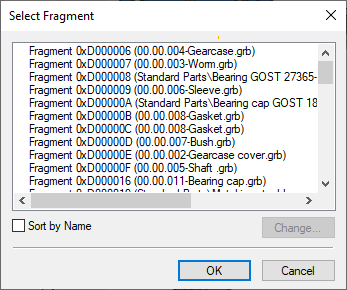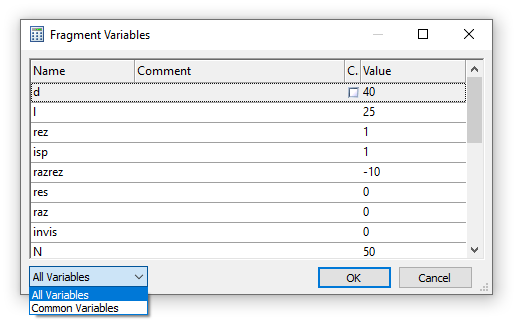Editing 2D Fragments |
  
|
Calling the command:
Icon |
Ribbon |
|---|---|
|
- |
Keyboard |
Textual Menu |
<EFR> |
Edit > Draw > Fragment |
As for any other T-FLEX element, the common selection and editing rules apply to a fragment. That means, selection of the necessary fragment for editing is done by clicking ![]() , while the option <P> or
, while the option <P> or ![]()
![]() is used for changing its parameters, etc.
is used for changing its parameters, etc.
To select multiple fragments, one can use the key combination <Shift>+![]() (for adding elements to the selected list), <Ctrl>+
(for adding elements to the selected list), <Ctrl>+![]() (excluding an element from the list) or the box selection.
(excluding an element from the list) or the box selection.
To select a fragment by name, use the option:
|
<S> |
Select Fragment from List |
This option can be helpful when the fragment with the known name is hard to find in the drawing. Besides, the option may be very helpful for editing the reference paths of several similar fragments simultaneously. A dialog box will appear in the screen, where you can select the desired fragment.
By default, the fragments appear in the list in the order of their insertion into the assembly drawing. The flag Sort by Name alters the order of fragments in the list. The graphic buttons Change allows changing the filename, the reference paths or both, of the selected element (or a group of elements) in the list.

The fragments which because of some reasons lost connection with the external file are marked with the question sign.
Selecting the option Change Name allows modifying the filename only, without changing the path. Selecting the option Change Path modifies the path to the fragment without changing its name. Selecting the option Change Name and Path modifies both the Name and the path of the fragment file.

We recommend using relative paths to the assembly or library rather than full paths, when inserting fragments. Using relative paths simplifies porting assembly drawings to different file systems.
In some cases, the system may automatically record the relative path to a reference with respect to the assembly file. Depending on the relative location of the fragment and the assembly file, the relative path to the reference may appear differently. The following table shows examples of relative path formats for fragment references:
Assembly location |
Fragment location |
Fragment reference path |
C:\Assembly.grb |
C:\Drawings\Parts\Part3.grb |
Drawings\Parts\Part3.grb |
C:\Drawings\Assembly_1\Assembly.grb |
C:\Part2.grb |
..\..\Part2.grb |
C:\Drawings\Assembly_1\Assembly.grb |
C:\Drawings\Assembly_1\Part1.grb |
Part1.grb |
Any |
Library "Bolts", file "Bolt_1.grb" |
<Bolts>Bolt_1.grb |
Follows are the rules that are accepted for the fragment reference relative path formats:
1. If the assembly is located at a higher level in the file tree, than the fragment, then the reference will be always relative to the assembly file. In this way, the portion of the full path to the reference, identical with that of the assembly file path, is removed, resulting in the relative path to the reference.
2. If the assembly is located deeper in the file tree, then the fragment, yet in the same tree branch of the file system, then T-FLEX CAD system will be able to create the relative path for the reference. In this way, to step up one level in the file tree, the system will use the notation "..\" in the beginning of the reference path. However, if the reference requires switching to another branch of the file tree, the user will have to specify the reference path manually, as the system won't be able to do this automatically.
3. If the assembly file and the fragment file are in the same folder, then the reference name will consist of just the fragment file name.
4. If the fragment file was inserted from an opened library, then the reference relative path will contain the library name, in brackets, and the fragment file name.
Upon selecting a fragment, it will be marked by an outlining rectangle. All fixing points or the fixing vector of the fragment will be highlighted.
External variables manipulators of 2D fragment
For additional convenience, the system allows modifying the fragment's external variables dynamically by the mouse, using specially provided manipulators. By default, manipulators appear automatically, as you start editing a fragment, which contains construction lines and 2D nodes that are defined by external variables. Manipulators of lines look like continuous blue lines, manipulators of nodes look like brown squares. Color of nodes' manipulators can be changed in system options (Options > Color > 2D Manipulators > Highlighting). Manipulator gets thickened upon hovering the mouse cursor over it. An icon near the cursor indicates type of a manipulator. Upon clicking ![]() a manipulator, corresponding line or node starts following the cursor. Move the line or node into a new position and click
a manipulator, corresponding line or node starts following the cursor. Move the line or node into a new position and click ![]() again to confirm the new configuration of a fragment. The manipulators can be disabled for a particular fragment in its document parameters (Document Parameters > Document > 2D Fragment > 2D Fragment > Enable manipulators on edit).
again to confirm the new configuration of a fragment. The manipulators can be disabled for a particular fragment in its document parameters (Document Parameters > Document > 2D Fragment > 2D Fragment > Enable manipulators on edit).


Variables Editing for Several Fragments
The system allows the simultaneous modification of the variables with the same name for several fragments at once. For modifying the fragment variables it is necessary to perform the following actions:
•select fragments on the drawing;
•invoke the context menu by pressing the right mouse button and choose the command Variables;
•introduce modifications in the dialog which appears.
Upon calling the command of the context menu Variables, the dialog with the list of variables of the selected fragments appears. This list may include either all variables of all fragments or only common variables (i.e., the variables with coinciding names). Control is carried out with a toggle Show variables at the bottom of the dialog.

The common variables in different fragments can have different values. In this case, for such variables opposite their value there will be a special control element – a flag which when being switched on will let a user change the value. Modification of the value for the common variable will be applied to all selected fragments.
Using Clipboard for Fragment Variables
When selecting a specific fragment with ![]() , the commands for copying variables from one fragment to another will be found in the context menu. The command Copy variables to clipboard copies values and expressions for the variables into the internal clipboard. The command Insert variables from clipboard replaces the values of the variables having the same name for the selected fragment with the values from the clipboard.
, the commands for copying variables from one fragment to another will be found in the context menu. The command Copy variables to clipboard copies values and expressions for the variables into the internal clipboard. The command Insert variables from clipboard replaces the values of the variables having the same name for the selected fragment with the values from the clipboard.

Editing Fragment in Assembly Context
The Open in Context option for editing in the assembly context is available in the context menu of the selected fragment and in the automenu of the command Edit Fragment.
Upon calling the option, all elements of the assembly drawing other than those belonging to the fragment are drawn in halftone, and the fragment elements become editable. As in the assembly-context fragment creation, the user can create and/or edit the fragment drawing. With the associative or non-associative snapping to assembly elements turned on, you can use nodes and lines of the assembly drawing as references. The commands for modifying the snap types and exiting the mode of work in the assembly context can be found in the context menu.

The options Refresh Fragment File and Refresh All Fragments Files are provided for updating the fragment document per the changes in the assembly when working by “Top-down” approach or in the assembly context. To update a single fragment, you can use the respective option in the automenu of the command Edit Fragment or the command Update, accessible in the context menu. To update all fragments per the changes in the assembly drawing, use the following command
Icon |
Ribbon |
|---|---|
|
|
Keyboard |
Textual Menu |
<FG> |
File > Fragment > Refresh Files |
See Also: